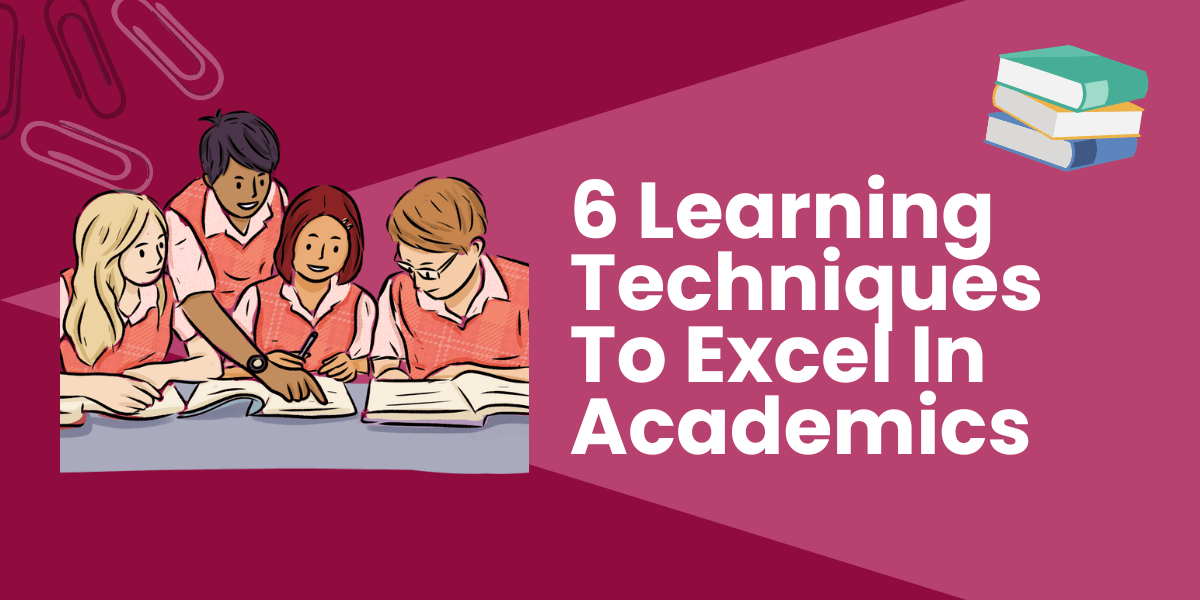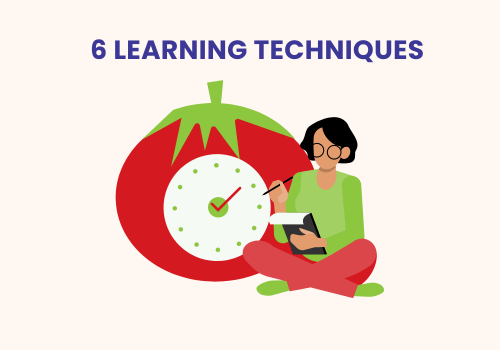6 Learning Techniques To Excel In Academics
August 23, 2023
Anis

Do you want to enhance your academic performance and excel in your studies?
The college education system is marked differently.
Hence, as a university student, you must adopt effective learning techniques to achieve academic success.
There are several learning techniques that you can incorporate into your daily routine.
They can help you to learn university course materials efficiently.
In this article, you will find helpful learning techniques to boost your academic performance.
6 Learning Techniques
1. Retrieval practice
Remembering information for a long time is based on the practice of retrieval.
Studies have shown memory recall is more effective than relying on textbooks or notes.
Consistent use of retrieval practice increases the chances of remembering information in the future.
Here are some ways to incorporate retrieval practice into your study routine.
You can challenge yourself by answering questions without referring to notes or textbooks.
Alternatively, you can also create flashcards and employ retrieval practice by writing down the answers to a question before checking it.
2. Spaced method
Spaced practice is studying over an extended period rather than cramming the night before.
This learning technique allows you to connect ideas and build upon your knowledge, making it easier to recall later.
However, spaced practice requires you to plan ahead. You must schedule time each day to study and review your course materials.
Hence, even if your exams are months away, this habit will help you stay accountable and better at retaining information.
3. SQ3R method
If you want to improve your reading comprehension skills, the SQ3R method can be useful.
This method encompasses five steps in identifying and retaining vital input from textbooks.
But what is the acronym SQ3R?
Survey means you begin your reading by skimming the first chapter.
Make sure that you take note of headings, subheadings, images, or charts.
This step requires you to jot down notes rather than reading the entire book.
Next, question is when you formulate questions based on the chapter's content.
For instance, you ask yourself what this chapter is all about.
After that, you must read the whole chapter and look for answers to your formulated questions.
Don't forget to recite (or summarize) what you have read in your own words.
Try recalling major points and answering questions from the second step.
Lastly, review the material to ensure that you understand the whole chapter.
You can quiz yourself on the questions you created and re-read the sections requiring further attention.
4. Feynman technique
If you want to learn a concept effectively, try the Feynman technique.
This method encourages you to explain a concept in laymen's terms (in your own words).
Here's how you can implement the Feynman method:
First, you write the concept you are studying on the top sheet of paper (or tablet, if you're using one).
Next, explain the concept in your own words. Imagine you are teaching your study buddies.
Afterward, you must review what you wrote and identify mistakes.
Revert to your notes or read the course material to correct them.
Don't forget to re-check if there are any complex terms. Change them in simpler terms to better understand and retain the terms.
5. PQ4R method
PQ4R is a learning technique to boost your memorization and comprehension of the subject matter.
Unlike SQ3R, this technique has 6 steps.
Firstly, you must preview the content by quickly scanning the material.
Read the headings, subheadings, and highlighted text.
Next, you must pose questions related to the topic.
Once you have listed the questions, you must read the information to identify answers.
Reflect on the answers that you have found. Does the answer satisfy you? If not, you must go back and find a more specific answer.
Recite a summary of the information by reading it in your own words. You can do this step verbally or by writing it on paper (or tablet).
Lastly, review the material once more and answer any remaining questions.
6. Color-coded notes

Taking messy notes during a lecture can make remembering important details difficult.
However, using color while writing is an effective way to organize your knowledge and prioritize essential ideas.
Color can enhance memory performance.
Warm colors such as red and yellow can create a positive and motivating learning environment that encourages learners to engage with the material.
These colors also increase attention and information retention.
To make the most of this technique, remember to write key points in red, highlight important details in yellow, and organize topics by color.
Avoid coloring everything and focus only on the most significant information.
As a university student, you can achieve academic excellence by mastering the right learning techniques.
For more study tips, you can click on the link below.
Also read: 8 Good Study Habits For University Students
Kickstart your education in Malaysia
We'll help you find and apply for your dream university
You might be interested in...
- Sunway University Partners with Universiti Kebangsaan Malaysia to Offer Medical Doctor Programme
- Sunway University Leads the Way as Host of THE Asia Universities Summit
- Sunway University Announces the Commencement of its LaunchX 2024 Cohort From March to August 2024
- Promoting Health and Well-being: Initiatives by Universities in Malaysia
- Raising Awareness of Microplastic Pollution on International Mother Earth Day
- Exploring Distance Learning: Course Offerings at Universities in Malaysia
- The Role of Education in Promoting Health Equity: Lessons from World Health Day 2024
- Navigating Credit Transfers: A Guide for Students Switching Institutions
- Explore the Benefits of Studying in Malaysia After SPM Examination
- SPM Leavers’ Guide to Malaysian Scholarships: Types, General Requirements, and Practical Tips









